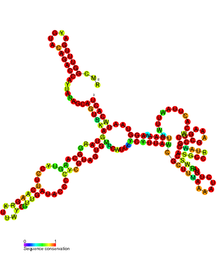- CspA mRNA 5' UTR
-
cspA 5' UTR 
Conserved secondary structure of the 5' UTR of cspA RNA Identifiers Symbol cspA 5'UTR Rfam RF01766 Other data RNA type Cis-reg; Thermoregulator; Domain(s) Enterobacteriales cspA mRNA 5' UTR is the untranslated region of the cspA gene, which is important in the cold shock response in Enterobacteriales such as E. coli. The 5' UTR element acts as an RNA thermometer, regulating the expression of cspA in response to temperature.[1]
The 5' UTR was first suspected to be significant when mutations within this region of cspA significantly increased the stability of the transcript at 37°C.[2]
The secondary structure of cspA mRNA changes in response to temperature; at 37°C the transcript is unstable and less efficiently translated than at lower temperatures.[3] Unlike other RNA thermometers (such as FourU), the secondary structure is not reliant on the melting of a hairpin in order to affect gene expression. Instead, in temperatures below 20°C a cis-regulatory region of ncRNA in the 5' UTR of cspA presents the Shine-Dalgarno sequence and AUG start codon to the ribosome in a more accessible way. The precise mechanism for changing the mRNA conformation is unknown.[1] cspA protein is then produced in significantly higher quantities, making up over 2% of the cell's proteome during cold shock.[4] cspA protein binds Hfq, which upregulates production of sigma factors which mediate a stress response.[5]
Contents
See also
- Hfq binding sRNA
- ROSE element
References
- ^ a b Giuliodori AM, Di Pietro F, Marzi S, et al. (January 2010). "The cspA mRNA is a thermosensor that modulates translation of the cold-shock protein CspA". Mol. Cell 37 (1): 21–33. doi:10.1016/j.molcel.2009.11.033. PMID 20129052. http://linkinghub.elsevier.com/retrieve/pii/S1097-2765(09)00966-6. Retrieved 2010-07-23.
- ^ Yamanaka K, Mitta M, Inouye M (October 1999). "Mutation analysis of the 5' untranslated region of the cold shock cspA mRNA of Escherichia coli". J. Bacteriol. 181 (20): 6284–91. PMC 103761. PMID 10515916. http://jb.asm.org/cgi/pmidlookup?view=long&pmid=10515916. Retrieved 2010-07-23.
- ^ Breaker RR (January 2010). "RNA switches out in the cold". Mol. Cell 37 (1): 1–2. doi:10.1016/j.molcel.2009.12.032. PMID 20129048. http://linkinghub.elsevier.com/retrieve/pii/S1097-2765(09)00967-8. Retrieved 2010-07-23.
- ^ Brandi A, Spurio R, Gualerzi CO, Pon CL (March 1999). "Massive presence of the Escherichia coli 'major cold-shock protein' CspA under non-stress conditions". EMBO J. 18 (6): 1653–9. doi:10.1093/emboj/18.6.1653. PMC 1171252. PMID 10075935. http://www.pubmedcentral.nih.gov/articlerender.fcgi?tool=pmcentrez&artid=1171252. Retrieved 2010-07-23.
- ^ Hankins JS, Denroche H, Mackie GA (May 2010). "Interactions of the RNA-binding protein Hfq with cspA mRNA, encoding the major cold shock protein". J. Bacteriol. 192 (10): 2482–90. doi:10.1128/JB.01619-09. PMID 20233932. http://jb.asm.org/cgi/pmidlookup?view=long&pmid=20233932. Retrieved 2010-07-23.
Further reading
- Goldstein J, Pollitt NS, Inouye M (January 1990). "Major cold shock protein of Escherichia coli". Proc. Natl. Acad. Sci. U.S.A. 87 (1): 283–7. doi:10.1073/pnas.87.1.283. PMC 53247. PMID 2404279. http://www.pnas.org/cgi/pmidlookup?view=long&pmid=2404279. Retrieved 2010-07-23.
- Gualerzi CO, Giuliodori AM, Pon CL (August 2003). "Transcriptional and post-transcriptional control of cold-shock genes". J. Mol. Biol. 331 (3): 527–39. doi:10.1016/S0022-2836(03)00732-0. PMID 12899826. http://linkinghub.elsevier.com/retrieve/pii/S0022283603007320. Retrieved 2010-07-23.
- Narberhaus F, Waldminghaus T, Chowdhury S (January 2006). "RNA thermometers". FEMS Microbiol. Rev. 30 (1): 3–16. doi:10.1111/j.1574-6976.2005.004.x. PMID 16438677. http://www3.interscience.wiley.com/resolve/openurl?genre=article&sid=nlm:pubmed&issn=0168-6445&date=2006&volume=30&issue=1&spage=3. Retrieved 2010-07-23.
External links
Categories:- Non-coding RNA
- Cis-regulatory RNA elements
Wikimedia Foundation. 2010.
